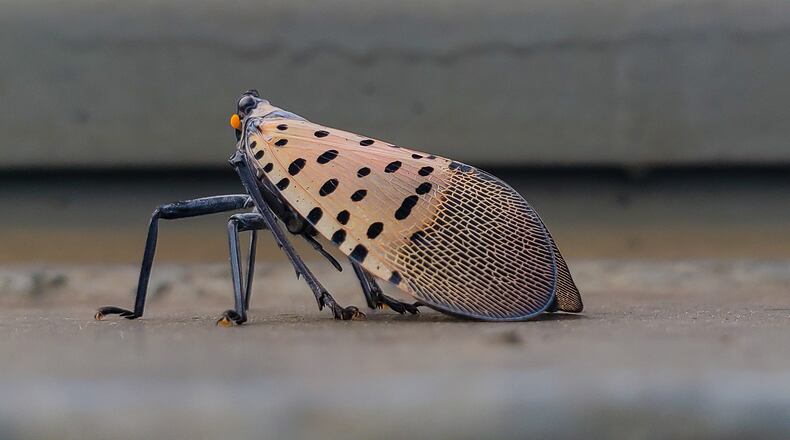The planthopper, Lycorma delicatula is non-native and was new to the United States in Pennsylvania in 2014. Currently, it has been found in several eastern states and most recently (last year) in Ohio.
While it resembles a moth or butterfly, it’s a planthopper and in the insect family Fulgoridae. The adult is quite pretty with its red, black, and white hind wings. When disturbed, the coloring is evident.
SLF doesn’t kill plants but is considered a plant stressor. That said, it can kill some species of plants, such as grapes or hops. Therefore, it can become quite a problem for those who enjoy wine or beer! It could also be a significant pest for the maple syrup industry.
SLF has one generation per year with incomplete metamorphosis. The eggs are laid in the fall, overwinter in the egg stage, hatch in July, molt several times until they become adult plant hoppers.
Both the nymphs (early stages) and the adults feed on plants, though the nymphs usually feed on smaller plants such as perennials and annuals. The adults feed on a wide variety of plant species, with grapes, tree of heaven, and maples being their favorites.
They have piercing and sucking mouthparts and insert these into the phloem and suck the sap from the plant. The adults produce copious amounts of honeydew (sticky excretion) which quickly grows sooty mold on top.
As a plant stressor, they can do enough damage to grapes and hops to eventually kill them. On other woody plants, such as maple, they send them into stress. For maple syrup, the trees need to be healthy to produce good quantities of sap.
The biggest problem for homeowners will be the sooty mold and the sheer nuisance factor of the SLF.
I had the opportunity to see this invasive species firsthand in 2018. My colleagues and I traveled to Berks County, Pennsylvania (the epicenter) for an in-service. At this time, the adults were in the egg-laying stage, and we saw the result of their feeding.
The sooty mold is a fungus that grows easily on honeydew, and it is black, and it was everywhere. On the woodland floor, on vehicles under maple trees, on anything that was need a feeding site. It was quite the mess.
While it might not kill your maples and other deciduous trees, it will certainly annoy the heck out of you!
Social media posts suggest smashing the SLF. However, PLEASE DON”T – at least for right now. We need to confirm when it is found in a county since it is just entering Ohio.
Right now, it’s in a few counties in Northeast Ohio. It’s likely in other Ohio counties, but we haven’t discovered it yet.
Now is the time to find this pest actively laying eggs. If you come across what you think is the SLF, please capture it (not the easiest as it hops and is fast) and contact me or your local county extension office or the Ohio Department of Agriculture.
More on this pest next week.
Pamela Corle-Bennett is the state master gardener volunteer coordinator and horticulture educator for Ohio State University Extension. Contact her by email at bennett.27@osu.edu.
About the Author

